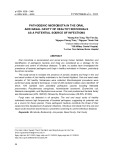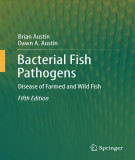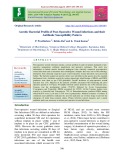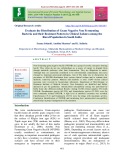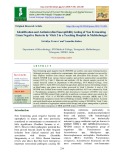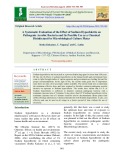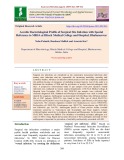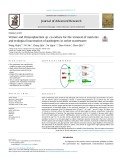
Aerobic pathogenic bacteria
-
This study aimed to evaluate the presence of aerobic bacteria and fungi in the oral and nasal cavities of Jrai healthy individuals in the Central Highland. Oral and nasal swab samples of 140 healthy Vietnamese were collected. Microbiological procedures were performed using standard techniques.
 8p
8p  vioraclene
vioraclene
 31-03-2024
31-03-2024
 4
4
 2
2
 Download
Download
-
Ebook "Bacterial fish pathogens: Disease of farmed and wild fish" is a comprehensive discussion of the biological aspects of the bacteria which cause disease in farmed and wild fish. Since the 4th edition was published in 2007, there has been an upturn in the application of molecular approaches to taxonomy, diagnosis and vaccine development. New pathogens, e.g. Aeromonas schubertii, have been described.
 678p
678p  tachieuhoa
tachieuhoa
 28-01-2024
28-01-2024
 5
5
 2
2
 Download
Download
-
Part 1 book "Bacterial fish pathogens - Disease of farmed and wild fish" includes content: Introduction; gram positive bacteria (anaerobes and ‘lactic acid’ bacteria); aerobic gram positive rods and cocci; aeromonadaceae representatives (motile aeromonads); aeromonadaceae representative (aeromonas salmonicida); enterobacteriaceae representatives.
 430p
430p  muasambanhan02
muasambanhan02
 25-12-2023
25-12-2023
 7
7
 2
2
 Download
Download
-
Post-operative wound infections remain a serious problem in spite of modern standards of preoperative preparation, antibiotic prophylaxis and operative technique. This study was undertaken to Isolate aerobic bacterial pathogens from clinically suspected post-operative wound infections and to determine their antibiogram. Samples that were sent to Microbiology laboratory from clinically suspected cases of post-operative wound infections were processed further.
 16p
16p  angicungduoc8
angicungduoc8
 07-11-2020
07-11-2020
 22
22
 2
2
 Download
Download
-
Non-fermenting gram negative bacilli (NFGNB) are a group of aerobic, non spore forming bacilli. They either do not use carbohydrates as a source of energy or degrade them through metabolic pathways other than fermentation. They are ubiquitous in nature. Although they are commonly considered to be environmental contaminants, they have emerged as important nosocomial pathogens. Aim of this study was to characterize the prevalence of NFGNB distribution from various clinical isolates and to evaluate their antibiotic sensitivity patterns.
 8p
8p  trinhthamhodang7
trinhthamhodang7
 31-08-2020
31-08-2020
 10
10
 1
1
 Download
Download
-
Eye is a complex and sensitive organ and is therefore more vulnerable to trauma and various infections. Indian population is vulnerable to infections of eye by virtue of subtropical climate, trauma and iatrogenic procedures. Infectious endophthalmitis is a threatening and potentially devastating intra ocular infection caused by an array of organisms.
 6p
6p  nguaconbaynhay7
nguaconbaynhay7
 15-08-2020
15-08-2020
 16
16
 1
1
 Download
Download
-
Non fermenting gram negative bacilli (NFGNB) are aerobic, non-spore forming bacteria. Although previously considered as contaminants, their pathogenic potential was proved by their frequent isolation from clinical samples and association with diseases.
 7p
7p  nguathienthan5
nguathienthan5
 04-06-2020
04-06-2020
 11
11
 1
1
 Download
Download
-
Sodium hypochlorite has been used as a proven disinfecting agent for more than 150 years. Of late, the ill effects of sodium hypochlorite on the human health and environment have come to light through studies of various agencies and governments are looking forward for proper recommendations. In the light of this, the current study gains lots of importance since there are only a few systematic studies available.
 7p
7p  trinhthamhodang1213
trinhthamhodang1213
 30-05-2020
30-05-2020
 5
5
 0
0
 Download
Download
-
The numbers of crèche facilities are on the increase because more women are becoming financial supports to their families in developing countries. Children become exposed to pathogenic agents most of which are resistant to antibiotic as re-infection is commonly placed in such facilities. In African countries, there are hardly minimum standards or monitoring of such facilities. This study focused on isolating aerobic pathogenic bacteria and determining their antibiotic sensitivity using four crèches in Redemption city.
 11p
11p  nguathienthan2
nguathienthan2
 26-12-2019
26-12-2019
 20
20
 1
1
 Download
Download
-
Surgical site infections are considered as the commonest nosocomial infections after urinary tract infections and are responsible for increasing morbidity, mortality and economic burden. Advances in infection control practices have not completely eradicated this problem because of emergence of multidrug resistant bacteria. Aim of the study is to determine the incidence of SSIs and the prevalence of aerobic bacterial pathogens with their.
 6p
6p  nguaconbaynhay1
nguaconbaynhay1
 08-12-2019
08-12-2019
 15
15
 1
1
 Download
Download
-
Swine wastewater poses chemical and biological risks because it contains high concentrations of ammonia and diverse species of pathogens. Herein, a vetiver-Dictyosphaerium sp. co-culture for the rapid removal of ammonia and the effective inactivation of pathogens was developed. Plants and microalgae benefited mutually and co-utilized the nutrients in the wastewater in the co-culture. The pathogens were inactivated by reactive oxygen species that were released by the microalgae as well as the supersaturated concentrations of dissolved oxygen in the enclosed bioreactor.
 8p
8p  trinhthamhodang1
trinhthamhodang1
 14-11-2019
14-11-2019
 15
15
 0
0
 Download
Download
-
Nocardiosis refers to disease caused by bacteria of the genus Nocardia. Pneumonia and disseminated disease are most common. Other forms include cellulitis, lymphocutaneous syndrome, actinomycetoma, and keratitis. Microbiology Nocardiae are saprophytic aerobic actinomycetes and are common worldwide in soil, where they contribute to decay of organic matter. Nocardial taxonomy is complex and incompletely understood. As taxonomy continues to evolve, any nocardiae isolated from a human should be considered potential pathogens.
 12p
12p  crazy_sms
crazy_sms
 08-05-2012
08-05-2012
 43
43
 3
3
 Download
Download
-
Microbiology S. aureus is a pathogen in more than half of cases of contiguous-focus osteomyelitis. However, in contrast to hematogenous osteomyelitis, these infections are often polymicrobial and are more likely to involve gram-negative and anaerobic bacteria. Hence a mixture of staphylococci, streptococci, enteric organisms, and anaerobic bacteria may be isolated from a diabetic foot infection or pelvic osteomyelitis underlying a decubitus ulcer.
 6p
6p  thanhongan
thanhongan
 07-12-2010
07-12-2010
 62
62
 3
3
 Download
Download
CHỦ ĐỀ BẠN MUỐN TÌM








